Sony A200: Entry DSLR Roundup
by Wesley Fink on October 20, 2008 1:00 AM EST- Posted in
- Digital Camera
Field Notes
In our review of the Sony A350 we complained about the optical viewfinder just about as much as we praised the Live View tilt LCD. The Sony A100 had one of the better APS-C viewfinders, so the "tunnel-vision" A350/A300 viewfinder was quite a disappointment by comparison. It was clear Sony had to make compromises in the optical viewfinder to accommodate the Penta-Mirror shift and dedicated Live View sensor used in the A350/A300.
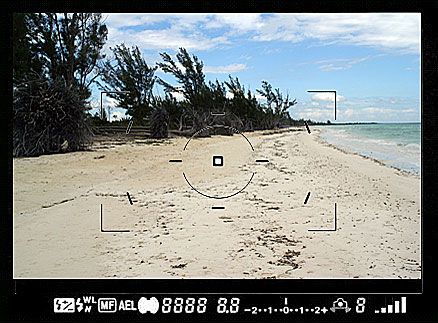
The A200 returns us to the big bright viewfinder of the A100. In fact, to our eyes the viewfinder appears unchanged from the A100 model, which is certainly a good thing. You also get a higher image magnification and a greater percentage of the total frame in the A200 viewfinder and on the LCD than you do on the A350/A300. This gives buyers a real choice. Traditionalists will prefer the A200 viewfinder, which is at least as good as anything in its class. Those who want a fast working Live View camera can choose the A350/A300, but users cannot get both a great optical viewfinder and great Live View in any current Sony camera.
Frankly, most of the competition's Live View implementations are slow as molasses and are not even close to the Sony A350/A300. However, they can be useful in non-action shooting situations or in the studio where the image magnification on the LCD can be very helpful for some critical focusing situations. Of course, who buys an entry DSLR for their studio? Today's Live View is more a checklist feature than a truly useful feature on entry cameras except the Sony A350/A300.
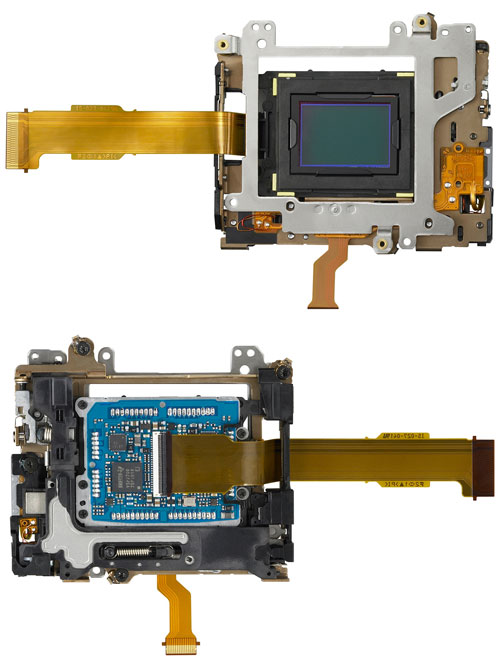
Image Stabilization and Auto Sensor-Cleaning Minolta was first with body-integral image stabilization and Sony has further refined a feature that most everyone but Canon and Nikon have adopted. It works very well on the A200 with up to 2 to 3 stops of added handheld capability. The Sony A200 IS works with any lens you can mount to the camera, and this includes current Sony lenses as well as millions of Minolta AF lenses that are often quite reasonable on the used market and on eBay. That same body IS also allows automatic sensor cleaning, which seemed to work well in under a wide variety of conditions. Our test cycle was just a few weeks but dust was never a problem with the A200 even though we used a wide variety of lenses in our testing.
Auto Focus In addition to more focus points and better focus tracking than many of their competitors, Sony claims the A200 Auto Focus is 1.7X faster than the A100. This is due to a higher torque motor and AF improvements borrowed from the newer A700. The AF module itself appears the same as the A100, but the AF speed in a side-by-side with the A100 found the A200 quite a bit faster in focusing. The A200 is not A700 fast, but the A700 is one of the fastest available in its class. However, compared to other entry models the A200 is one of the fastest focusing models.

Image Quality The Sony sensor is one of those components that promises more than expected if compared on price alone. The Sony 10.2MP CCD is a mature sensor that has been on the market for about two years. It is revised, refined, and coupled with a fast, recent Bionz processor in the A200. As a result, the A200 has a wider ISO range than others in the $499 price class. If you move up a notch to the $599 class the A200 still holds its own in image quality against any competitor. Image quality of the A200 is excellent, consistent, and dependable - which is a nice combination in an entry DSLR.
Controls The A200 is a model of simplicity in controls, but that should not be misread as lacking adjustment control. There is only one dial, where you select the all-auto mode, Program, Aperture-Priority, etc. and the Scene Modes.
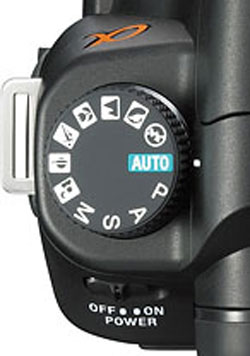
In Program mode there is a shift feature that is easy to use to control exposure. Turning the single front dial maintains the auto exposure but shifts the shutter speed (and corresponding aperture) to give more exposure choices. The single command dial is a concession to entry level, as was the single dial on the A100. The A700 has two dials with the front shifting shutter and the rear aperture in program shift. However, you can choose to have aperture instead of shutter as the shift parameter in the A200 menus.
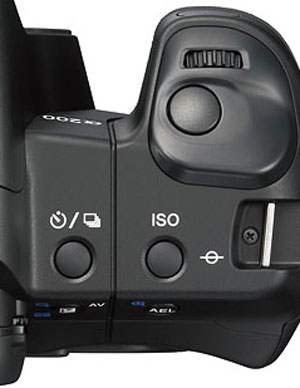
The top right features buttons for instant selection of ISO and Drive mode. The values are displayed on the rear LCD and can be adjusted with the joy-pad.
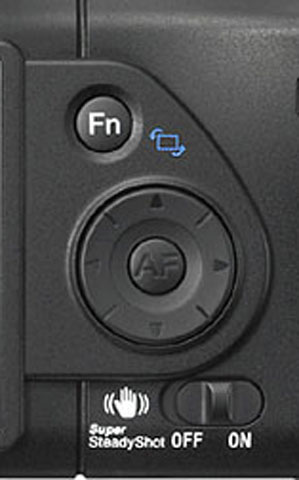
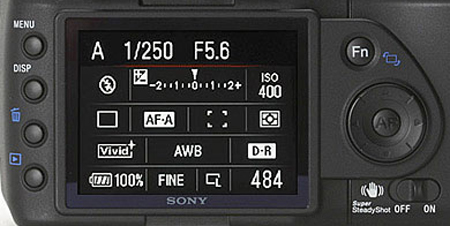
One of the nicest features of Sony DSLRs is the Fn button to the right of the LCD. This button brings up the Fn screen which allows adjustment of all the major parameters of the camera in one convenient place. Recent models from other manufacturers are featuring a similar feature, with the Canon 50D the most notable convert to the menu-less one screen adjustment summary.
DRO (Dynamic Range Optimizer) The Sony A200 is not a stripped entry model as many of its competitors are. The best example of this is the fact that Sony includes their DRO feature in the A200, which allows dynamic range expansion in captured images. It is even adjustable in the A200. This is certainly not a feature you would normally expect to find in an entry DSLR.
Ease of Use Sony has earned a deserved reputation in the DSLR market for simplicity or ease-of-use. We suspect this is more the result of the influence of Minolta engineers than Sony designers since the Sony point-and-shoots are often extremely complex and unintuitive. We do hope that Sony DSLR ease-of-use continues in the future.
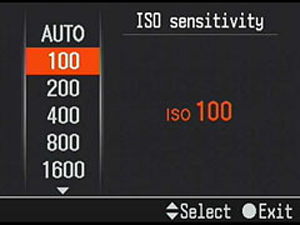
Auto ISO is another Sony feature that is very useful. In Auto ISO the camera selects the ISO to keep the exposure in a range that will likely produce sharp pictures. The Auto range is optimized and varies depending on the shooting mode selected or the Scene selection. Unlike some competitors, Sony has not really crippled the A200 or removed features to match a lower price point. All of the A100 features and options are continued or expanded in the A200 except for the Depth-of-Field preview button on the front, which was a victim of cost-cutting. But the ISO range is wider and the operation is even faster than the well-respected A100.
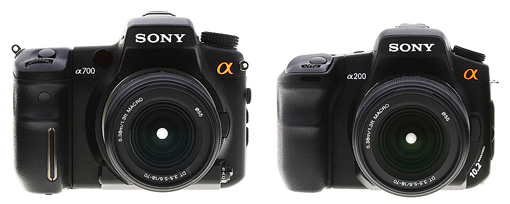
Handling The A200 is certainly smaller than the prosumer A700, but it is still larger than the similarly priced Nikon D60 and Canon XS entry models. Weight, however, is similar to these two competitors. Frankly, some have real issues with the small size of the D60 and Canon XS and prefer the Canon handling with the optional battery grip. Of course, the Nikon does not offer an optional battery grip so the D60 can't grow for better handling.
The A200 is a bit larger than the Canon and Nikon entry and fits larger hands better. If you find the XS/XSi and D60 too small for your liking, you will like the Sony A200 handling. Sony also makes an optional Battery Grip for the A200, and it is the same grip that fits the A300/A350. The A100 did not have a grip option.
Overall the ergonomics of the A200 seem to be right on target. It is easy to hold and operate and it is a further refinement of the A100 it replaces. If size is your main concern, however, the Canon, Nikon, and Olympus entry models are even smaller, though some complain they are too small for a DSLR and hamper ease-of-use.
Customization The A200 is one entry model that certainly does not look or behave like one. The only hints that this is not a midrange model are the lack of a depth-of-field preview button and just one command dial. However, features and options are otherwise what you would expect on a much more expensive camera. Bracketing control is present and not missing like the Nikon D60. Wireless flash control is present, unlike the Nikon D60 or the Canon XS, as is body image stabilization, unlike the Olympus E420.
As already pointed out Live View is not an A200 feature. If that matters to you move up to the A300 at $599. The A300 uses the same sensor as the A200 and features a real fast focus tilt LCS for Live View. If the real usefulness of the Live View is not so important you could select one of the A200 competitors in the entry class, all of which feature slow Live View as a feature for sometimes use.










32 Comments
View All Comments
deathwalker - Wednesday, October 22, 2008 - link
Broadway Photo has the A200 kit for $321..great deal.strikeback03 - Wednesday, October 22, 2008 - link
http://www.resellerratings.com/store/Broadway_Phot...">http://www.resellerratings.com/store/Broadway_Phot...good luck with that. Here is what they look like:
http://donwiss.com/pictures/BrooklynStores/h0006.h...">http://donwiss.com/pictures/BrooklynStores/h0006.h...
and
http://donwiss.com/pictures/BrooklynStores/h0049.h...">http://donwiss.com/pictures/BrooklynStores/h0049.h...
AkumaX - Friday, October 24, 2008 - link
It's hard to decide which camera to go for the coveted Entry Level DSLR position. Plenty of friends consider Canon or Nikon as the major players, and own either one.Having the opportunity to pick up the A200K for $413 shipped/no tax from SonyRewards last June helped factor in that decision. As a person who had zero experience or knowledge of the SLR domain, this was quite a gamble.
So for the past 4 months, haven taken over 8000 pictures (in RAW), and been to 2 foreign countries, this was definitely worth the investment. The biggest thing Sony has going for them is the backwards compatibility of the Minolta AF lens line.
I picked up a 50mm f/1.7 + 70-210mm f/4 (the "beercan") off CraigsList, since these seem to be "the" lenses to get. Having researched throughout these past few months about aperture, ISO, crop factor, etc... I'll probably pick up a 28mm f/2.8 also.
All in all, the Sony A200K offers a lot: 18-70mm kit lens - bigger than the rest, Minolta AF (Maxxum) Lens backwards compatibility, and plenty of alpha-based accessories. This one seems like a winner.
What am I doing? --> blog.anandtech.com/manthisiswhathappenswhenyoucantsleepandramble
cafmike1 - Monday, April 19, 2010 - link
I am waiting on the replacement SLR for the Nikon D90 herehttp://www.cameta.com/Nikon-D90-Digital-SLR-Camera...
Does anyone know when this thing is going to be announced?
Wineohe - Tuesday, October 21, 2008 - link
Hmm. I'm more critical of the ISO performance of the Sony A200. It just doesn't seem that good above 800. The Nikon and Olympus are decent and the Canon is affected by some softness and chromatic aberrations at all ISO settings, something that I attribute to it's junk lens. Given a better lens it would probably show it's stuff, but this is a budget comparison and that would be unfair. I wish Canon would spend even $3 more on making their cheapo 18-55.In general all of these camera packages boarder on being just too much of a compromise. However as I mentioned above the Olympus and the Nikon come close to being acceptable. Frankly I really don't care how many features the camera has if the output is just mediocre. An adequately equipped body with a step up lens is far better advise.
Heidfirst - Wednesday, October 22, 2008 - link
shoot RAW & pp. Sony's jpeg engine isn't the greatest.strikeback03 - Thursday, October 23, 2008 - link
I'd agree for higher level bodies, but the distinction probably isn't relevant for most consumers at the $500 price point.Wesley Fink - Wednesday, October 22, 2008 - link
The Canon lens used for testing was their excellent 50mm f1.4, so you can't blame the results on a cheapo lens. All of the tests used 50mm f1.4 primes execpt the Olympus where a 35mm macro was used because of the 2x lens factor. ALL these lenses are in the best part of their resolution curves at f/4, which was a requirement.Snapshots and regular images published in our reviews do use the kit lens, but not our noise tests.
Wineohe - Wednesday, October 22, 2008 - link
Oooh, my bad, I missed that. I actually have a 50mm f1.4 that I use occasionally on my 5D. It struggles in low light but otherwise is a fine lens. I was convinced the characteristics were that of poor optic since they seem to exist at low or high gain. Now I'm left scratching my embarrassed head. So much for the XS, it is getting long in the tooth.haplo602 - Tuesday, October 21, 2008 - link
I think you are using a few features in the A200 that are not even used by the buyers in this price range.wireless flash ... I mean come on ... what is the lowest priced Sony external flash that will work with this ? I found the HVL-F42AM as the lowest level model for about 1/2 the price of the A200 kit. No entry level DSRL user will shell out that much money for external flash, they will buy a better body in the first place.
generaly the people getting into this class DSLRs come from the P&S user group. They will still compose mostly with live view, so number of AF points is irelevant. Anyway what's the performance of the 9 focus points ? Only center one is a cross sensor ? Then the other ones will be a source of frustration for the P&S crowd in most conditions :-)